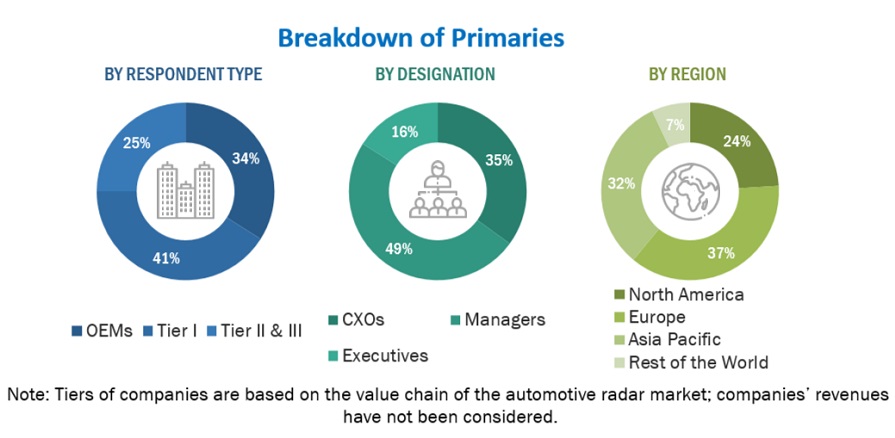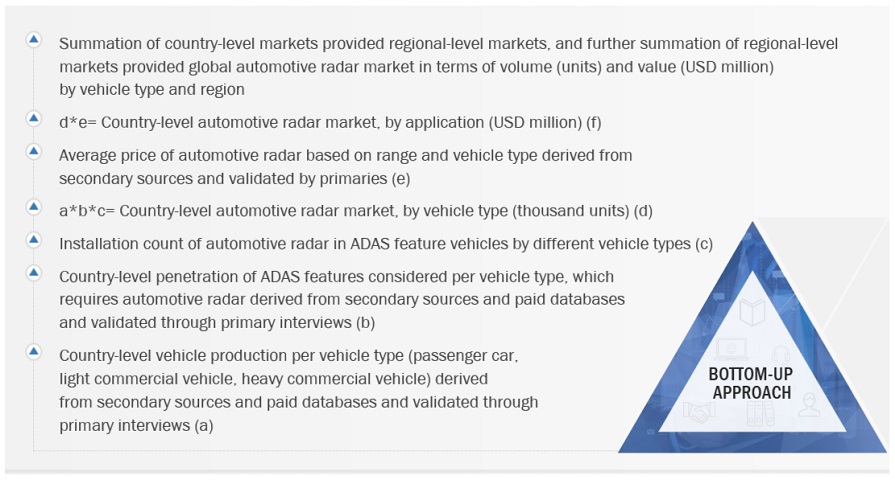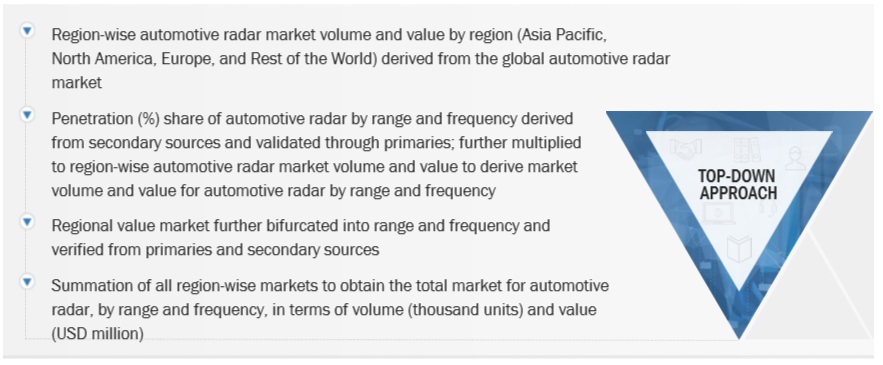This research study involved extensive secondary sources, directories, and databases, which were used to classify and gather the facts and figures useful for the technical, market-oriented, and commercial study of the automotive radar market. Primary interviews were conducted to obtain and verify critical inputs on qualitative and quantitative information and to assess the prospects of the automotive radar industry. Primary sources mainly included experts from the core and related industries, suppliers, manufacturers, distributors, technology developers, and organizations related to various segments of this industry’s value chain. Detailed interviews were conducted with various primary respondents, including key industry participants, subject matter experts, C-level executives of key market players, and industry consultants.
Secondary Research
In the secondary research process, various secondary sources were used to identify and collect information for this study. The secondary sources include annual reports, press releases, and investor presentations of companies; whitepapers, certified publications; articles from recognized authors, directories, and databases; and articles from recognized associations and government publishing sources. Secondary research has been used to obtain key information about the industry’s value chain, the overall pool of key players, market classification and segmentation according to industry trends to the bottom-most level, regional markets, and key developments from the market- and technology-oriented perspectives.
Primary Research
Extensive primary research was conducted after understanding the automotive radar market scenarios through secondary research. Several primary interviews were conducted with market experts from both the demand (country-level government associations, trade associations, institutes, R&D centers, and automotive radar manufacturers) and supply (automotive radar manufacturers, automotive radar component manufacturers, and raw material suppliers) sides across four major regions, namely, North America, Europe, Asia Pacific, and the Rest of the World. The experts involved in primary interviews are 20% from the demand side, and 80% from the industry's supply side. Primary data was collected through questionnaires, emails, and telephonic interviews. Several primary interviews were conducted from various departments within organizations, such as sales, operations, and administration, to provide a holistic viewpoint in the report.
After interacting with industry participants, some brief sessions were conducted with experienced independent consultants to reinforce the findings from the primary interviews. This, along with the in-house subject matter experts’ opinions, led to the findings delineated in the rest of this report.

To know about the assumptions considered for the study, download the pdf brochure
Market Size Estimation
The bottom-up approach has been used to estimate and validate the size of the automotive radar market. In this approach, the country-level vehicle production has been derived from secondary sources and various databases and validated through primary interviews. Further, country-level penetration of various ADAS levels of vehicles and automotive radars installed by vehicle type has been derived. The penetration of ADAS features vehicles and the number of radars per vehicle (based on vehicle type) is being studied; based on that, the total number of automotive radars per vehicle has been considered.
The average selling price of automotive radar based on vehicle and range has been derived from secondary sources, and primary sources have validated the same. The automotive radar market volume (units) by vehicle type has been multiplied by the average selling price of automotive radar. This has provided the market by vehicle type in terms of value, and the summation of country-level markets has provided the regional-level markets. A further summation of regional-level markets has provided the global market in terms of volume and value by region and vehicle type.

To know about the assumptions considered for the study, Request for Free Sample Report
The top-down approach has been followed to determine the market size by range and frequency in terms of volume and value for the automotive radar market. The global market has derived the market volume and value by region (Asia Pacific, North America, Europe, and the RoW). The percentage share of the market by range and frequency has been derived from secondary sources and validated through primary sources. It has been further multiplied by region-wise market volume and value. Through this, the market volume and value for automotive radar by range and frequency have been derived. The summation of all region-wise markets has been carried out to obtain the total market by range and frequency in terms of volume (thousand units) and value (USD million).

Data Triangulation
The market was split into several segments and subsegments after arriving at the overall market size—using the market size estimation processes as explained above. Data triangulation and market breakdown procedures were employed to complete the overall market engineering process and arrive at the exact statistics of each market segment and subsegment. The data was triangulated by studying various factors and trends from both the demand and supply sides.
Market Definition
The word radar is an acronym derived from ‘Radio Detection and Ranging’. A device or electronic system detects and tracks objects at certain distances. A radar can detect any change within its covered range with the help of radio energy traveling at the speed of light. Whenever an object travels through the observed range, short bursts of radio energy are transmitted, reflected off a target or an object, and returned as an echo. The form of the electromagnetic signal radiated by the radar depends on the type of information required for the target.
The automotive radar sensor is an object-detection device that uses radio waves to determine the range, altitude, direction, and speed of objects within the range of the vehicle. It provides long to short-range functionality, allowing automotive systems to monitor the environment around the vehicle to help prevent crashes. It can detect, search, and track pedestrians, obstacles, motor vehicles, and terrain. The automotive radar is applicable for blind spot detection, adaptive cruise control, lane change assistance, and crash avoidance.
List of Key Stakeholders
-
ADAS Integrators
-
Automotive Radar Component Manufacturers
-
Automotive Radar Manufacturers
-
Automotive Software and Platform Providers
-
Autonomous Driving Platform Providers
-
Government and Research Organizations
-
National Highway Traffic Safety Administration (NHTSA)
-
Raw Material Suppliers for Automotive Radar
-
Transport Authorities
-
Vehicle Safety Regulatory Bodies
Report Objectives
-
To segment and forecast the automotive radar market in terms of volume (thousand units) and value (USD Million)
-
To define, describe, and forecast the market based on vehicle type, range, frequency, propulsion, application, and region
-
To analyze regional markets for growth trends, prospects, and their contribution to the overall market
-
To segment and forecast the market by vehicle type (passenger car, light commercial vehicle, heavy commercial vehicle)
-
To segment and forecast the market by range (short-range radar, medium-range radar, long-range radar)
-
To segment and forecast the market by frequency (2X-GHz, 7X-GHz)
-
To segment and forecast the market by propulsion (ICE and electric)
-
To provide qualitative insights on the market based on application [adaptive cruise control (ACC), autonomous emergency braking (AEB), blind spot detection (BSD), forward collision warning system (FCWS), intelligent parking assistance (IPA), cross traffic alert (CTA), lane departure warning system (LDW) and traffic jam assist (TJA)]
-
To forecast the market by region [North America, Europe, Asia Pacific, and the Rest of the World (RoW)]
-
To analyze technological developments impacting the market
-
To provide detailed information regarding major factors, such as drivers, restraints, opportunities, and challenges, influencing the growth of the market
Available Customizations
With the given market data, MarketsandMarkets offers customizations in accordance with company-specific needs.
-
Additional company profile (Up to 5)
-
Automotive radar market, by type, at the country level
-
Automotive radar market, by frequency, at the country level



Growth opportunities and latent adjacency in Automotive Radar Market